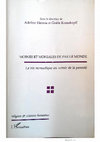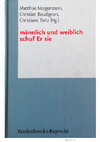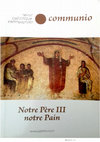Papers by Christian Boudignon
Revue Philosophique de Louvain, Sep 1, 2015
Ce document a été généré automatiquement le 23 septembre 2020. Tous droits réservés Alain LE BOUL... more Ce document a été généré automatiquement le 23 septembre 2020. Tous droits réservés Alain LE BOULLUEC, Alexandrie antique et chrétienne. Clément et Origène, deuxième édition revue et augmentée
Revue de l'histoire des religions

A. Herrou et G. Krauskopff (éd.) Moines et moniales de par le monde, la vie monastique au regard de la parenté (Religions et Sciences humaines), L’Harmattan, Paris,, 2009
This paper deals with the question of monks' family tights through Emperor Justinian's Novels 5, ... more This paper deals with the question of monks' family tights through Emperor Justinian's Novels 5, 123 and 133 on monasticism and Maximus the Confessor's Letter 12 to John Cubicularius on the problem of daughters supposedly taken away from their family to become (monophysite) nuns in Carthago in 641 A.D. The Novels 5 and 123 edict that the wealth of the new monk (or nun) returns to his family as if he were dead.The Novel 133 prevents family member to enter the monastery "since there is no family on earth for monks". Maximus Letter 12 seems to be caused by the crisis of 641 where the arrival of Oriental monks and nuns in Carthago stirs up a new symbolic family modell inside the monastery against the authority of Paterfamilias in the traditional family. The papers ends with some remarks on some monastic family terms like "abba" or "amma" or "adelphè" (sister) used by Maximus in this Letter.

M. Morgenstern, C. Boudignon et C. Tietz (éd.), ‘Männlich und weiblich schuf Er sie’, Studien zur Genderkonstruktion und zum Eherecht in den Mittelmeerreligionen, Vandenhoek & Ruprecht, Göttingen, 2011
The paper (p. 223-232) is preceded by the introduction to the whole symposium (p. 9-12)
Abstra... more The paper (p. 223-232) is preceded by the introduction to the whole symposium (p. 9-12)
Abstract of the paper
Our analysis plans to show that in the 7th century Byzantium two marriage modells were at stake. The first one is the endogamic marriage within the family clan with a important role attributed to the mother (even receiving inheritance in case of death of the husband). The second one, still underground at that time, but popular among cities, where the wife enters another clan : in this case, marriage is a "private event" as said by Emperor Heraclius. The mother has then not the same role as in the other marriage. May it be that the condemnation of Emperor Heraclius' second marriage with his niepce Martina in 622/623 A.D. and of her pretention to the throne after his death in 640 A.D. should be examinated in that way (that is to say in the opposition between two modells) ? The question of legal prescription on these topics is also faced as well as the positions of the author of Nikephoros' Short History (1st part) and of Maximus Confessor towards Empress Martina
French blue-print of the text is given in other post under the title "L’empereur peut-il épouser sa nièce ? Approches juridiques et pratiques dans le septième siècle byzantin" version française préparatoire"
A. Lévy, P. Annala, O. Hallamaa, T. Lankila et D. Kialey (éd.), The architecture of the cosmos, St. Maximus the Confessor, New perspectives (Schriften der Luther-Agricola-Gesellschaft 69), Luther-Agricola-Society, Helsinki, 2015
The paper aims at showing that the "blessed elder" (in Greek "makarios gerôn") in Maximus' Mystag... more The paper aims at showing that the "blessed elder" (in Greek "makarios gerôn") in Maximus' Mystagogy may be identified to the Pseudo-Macarius. Especially, the sentence of Pseudo-Macarius' 52nd homily : "the rational soul, made according the image of God, is the true Church of God" may be seen as the clue of the first chapters of Maximus' Mystagogy...
D. Albera, M. Crivello et M. Tozy (dir.) Dictionnaire de la Méditerranée, Arles, 2016
How appeared the idea of monotheism ? This article of "The Dictionnary of Mediterranean Sea" deal... more How appeared the idea of monotheism ? This article of "The Dictionnary of Mediterranean Sea" deals with the history of monotheism in three steps :
1. The birth of monotheism in the Jewish community of Babylon (6th c. before Christ) 2. The "crystallization" of monotheism in the Palestinian Judaism (2nd c. before Christ) 3. Its political triumph in the Roman Empire through the Christianity as State Religion (in 392 after Christ).
Y. Durbec et Fr. Trajber (éd.), Tradition épique et poésie épigrammatique, (Hellenistica Groningana 22), Peeters, Louvain, 2017
The only epigram of Sophronius of Jerusalem (Anthologia Palatina 1,123) about the Calvary stone i... more The only epigram of Sophronius of Jerusalem (Anthologia Palatina 1,123) about the Calvary stone in Jerusalem, will be studied in this paper in relation with other poetic texts of the same author : the Anacreontica 20, 18 and 14 (and the epigram Anthologia Palatina 1,10 not written by Sophronius). Sophronius' epigram will be seen as a counter-epic text inspired by Homer.
English translation of this epigram of the Anthologia Palatina 1,123 (by Alan Cameron, The Epigrams of Sophronius, Classical Quarterly, 33/1, 1983, p. 291) : "Thrice-blessed rock, who didst receive the blood that issued from God, the fiery children of Heaven guard thee around, and Kings, inhabitant of Earth, sing thy praise."

, 2017
La quatrième demande du Notre Père "Notre pain epiousios donne-nous le aujourd'hui", requête très... more La quatrième demande du Notre Père "Notre pain epiousios donne-nous le aujourd'hui", requête très concrète du pain matériel, fait l'objet de ré-élaborations dans le cadre de la polémique chrétienne contre la prière païenne. Quelles sont-elles ? La traduction grecque et à plus forte raison latine de la prière sémitique du Notre Père apparaît problématique. Comment comprendre l'adjectif "epiousios" qui qualifie le pain demandé ? S'agit-il du pain quotidien, supersubstantiel ou du pain du lendemain ? On abordera les commentaires de Tertullien, Cyprien de Carthage, Augustin et Jean Cassien côté latin, et d'Origène, Grégoire de Nysse, Jean Chrysostome, Théodore de Mopsueste et Maxime le Confesseur, côté grec.
The fourth request in the Lord Prayer "GIve us today our bread epiousios" is about material bread but has been many times reinterpreted in the christian polemics against pagans. What are those reworking of the meaning of this sentence ? And how is to understand the epithet "epiousios" in this greek translation of a semitic substrate ? Dealing with Latin and Greek Chrurch Fathers, we will face the meaning of "epiousios" as either "daily", or "supersubstantial", or "of tomorrow"
Communio 42/2, n°250, 2017
First complete translation from coptic to french of a little "Commentary to the Lors Prayer" of E... more First complete translation from coptic to french of a little "Commentary to the Lors Prayer" of Evagrius Ponticus by Nathalie Bosson (with notes by Christian Boudignon)
P. Lanfranchi et J. Verheyden (éd.), Jews and Christians in Antiquity, A regional perpective (Interdisciplinary Studies in Ancient Culture and Religion 18), Peeters, Louvain, 2018
This paper focuses on the image of the Jews in Sophronius of Jerusalem's "Miracles of the Holy C... more This paper focuses on the image of the Jews in Sophronius of Jerusalem's "Miracles of the Holy Cyrus and John", on the use of a "magic" pig and on a sand baptism of a Jew. It deals also with a group of Palestinian thieves of different religions (including Jews) in the "Spiritual Meadow" of John Moschus. This article faces also the issue of "Kulturkampf" between Jews and Christians and that of forced baptism of Jews.
E. M. Van Opstall (éd.), Sacred Thresholds, The Door to the Sanctuary in Late Antiquity (Religions in the Graeco-Roman World 185), Brill, Leyde,, 2018
The aim of this paper is to study the different senses of the entrances in the first three Greek ... more The aim of this paper is to study the different senses of the entrances in the first three Greek liturgical commentaries. Most important in the Pseudo-Dionysius commentary is what happens in the space for the priests from where sanctity overflows to the faithful. In Maximus' Mystagogia, the passage through the doors expresses a change of state (birth, virtue) and a separation of the high priest from the laity. In Germanus Historia Mystica, the first entrance represents through iconic items the birth of Christ...
G. Bady et D. Cuny (éd.), Les polémiques religieuses du Ier au IVe siècle de notre ère, Hommage à Bernard Pouderon, Beauchesne, Paris, 2019
The aim of this paper is to show that Gregory of Nazianus constantly defended in his "Orationes" ... more The aim of this paper is to show that Gregory of Nazianus constantly defended in his "Orationes" a philosophically inspired Christian form of non-violence, and to wonder why, in this context, he reproaches Emperor Constantius II for having spared in 337 AD the life of the young Julian, who was to succeed him as Emperor in 361AD. This contradiction may be solved in different ways. The author tackles the opportunity to examine Gregory stances in the face of the violence of his time.
Ph. Hoffmann et A. Timotin (éd.), Théories et pratiques de la prière à la fin de l'Antiquité, 2020
Seneca's 41th "Letter to Lucilius" and Tertullian's "De oratione" have some similarities. Because... more Seneca's 41th "Letter to Lucilius" and Tertullian's "De oratione" have some similarities. Because of the "spiritus" of the universe, the "anima mundi" that pervades the whole, there is in all being a form of prayer, even in the beasts. As the "ratio" in Seneca's Letter gives advice to the praying man's soul, so by Tertullian, the Verb gives the Our Father prayer to his disciples. And as for Seneca, the prayer is a philosophical meditation even for Tertullian.
G. Bady and M.C.A. Korpel (eds), Les délimitations éditoriales des Écritures des bibles anciennes aux lectures modernes, 2020
In the Quaestiones ad Thalassium, dated 630s, Maxime answers to
Thalassios, higumen (abbot) of Ca... more In the Quaestiones ad Thalassium, dated 630s, Maxime answers to
Thalassios, higumen (abbot) of Carthage, about words, verses or para-
graphs of the Bible. It seems that Thalassios uses lucianic sections to
allow his correspondent to find his way in the Bible.
Dans les Questions à Thalassios, qu’on date des années 630, Maxime
répond aux questions de Thalassios, higoumène de Carthage, sur des mots, des versets ou des paragraphes de la Bible. Il semble que Thalassios utilise des sections lucianiques pour permettre à son correspondant de se repérer dans la Bible.
Matthieu Cassin, Hélène Grelier-Deneux & Françoise Vinel (éd.),Gregory of Nyssa: Homilies on the Our Father. An English Translation with Commentary and Supporting Studies, 2021
The title of the "Homelies on the Our Father" in various manuscripts as ΠΕΡΙ ΠΡΟΣΕΥΧΗΣ, the Orige... more The title of the "Homelies on the Our Father" in various manuscripts as ΠΕΡΙ ΠΡΟΣΕΥΧΗΣ, the Origenian opposition between ΕΥΧΗ and ΠΡΟΣΕΥΧΗ in the same text, the strange first part of the first homely on the prayer in general, the echoes to the controversies between Platonists and Stoics on prayer, the ΣΠΟΥΔΑΙΟΙ as the public to which those Homily are written seem to prove that Gregory of Nyssus is inspired by Origen's ΠΕΡΙ ΕΥΧΗΣ

Bram Demulder & Peter van Deun (ed.), Questioning the World, Greek Patristic and Byzantine Question-and-Answer Literature, , 2021
The purpose of this paper is to study the possible links between Maxi-
mus the Confessor’s Mystag... more The purpose of this paper is to study the possible links between Maxi-
mus the Confessor’s Mystagogia and Iamblichus’ Letter of Abamon ,
better known as De mysteriis Aegyptiorum. The Maximian notions
of image and figure reflect the Iamblichean idea of symbols, the causes
and models of which are the gods. In the first part of the Mystagogia,
the church is described as image and figure of God and of the world.
This is to be read in connection with Iamblichus’ division of the
universe into three elements: cult statues, divine stars, and invisiblegods, along with the idea that the statues are reflections of the gods.
In the second part of the Mystagogia, the entrance of the high priest
into the church could recall the telestic art, the ritual which aims
to summon the divine in the statues. Its effectiveness is based upon
the correspondences between the intelligible and the sensible which
the ‘universal sympathy’ supposes. But neither liturgy nor theurgy
are pure magic, because they are deemed to raise the soul of the faith-
ful or of the theurgic priest up to the divine union, through purifi-
cation and contemplation. One problem remains: how to understand
the effect of the theurgy or liturgy on the faithful who are ignorant
or materialist?
H. Amirav, C. Hoogerwerf C. and I. Perczel (eds), Christian Historiography between Empires, 2021
The main themes of the first part of Nikephoros' "Short History" are to defend the idea of that t... more The main themes of the first part of Nikephoros' "Short History" are to defend the idea of that the Constantinopolitan Patriarch Pyrrhos is the real representative of political legitimacy, to blame the emperor Heraklios for his union with Martina and to restore the honour of Pyrrhos when he quitted. May this text be written by a supporter of Patriarch Pyrrhos ?
Vladimir Cvetkovic & Alexis Léonas, Studies in Maximus the Confessor's Opuscula theologica et polemica, 2022
The 27 "Opuscula theologica et polemica", as a cohesive collection, are a creation of François Co... more The 27 "Opuscula theologica et polemica", as a cohesive collection, are a creation of François Combefis in 1675. Yet those Opuscula have no real unity, neither of thought, nor of date, nor of genre. It is difficult to distinguish them from the 45 "Letters" edited by the same Combefis.
Manuel Sartori & Elodie Attia, Etudes sémitiques, Mélanges offerts à la mémoire de Philippe Cassuto, 2023
The treatise 9a (in the Basha's edition) of Theodore Abū Qurra deals with the question of miracle... more The treatise 9a (in the Basha's edition) of Theodore Abū Qurra deals with the question of miracle as a religious proof. Against the islamic leadership, Theodore ʾAbū Qurra developped the idea that the conversion (as he wrote) of the 5 sixth of humanity to Christianity would be the proof of the superiority of this religion over judaism (and islam). The paper ends with the french translation of the treatise.
Orients pluriels Liber Amicorum Samir Arbache, 2022
Theodore Abû Qurra, one of the first Christian Arabic writer in the 9th Century after Christ, wro... more Theodore Abû Qurra, one of the first Christian Arabic writer in the 9th Century after Christ, wrote a treatise on religious conversions (treatise 4 in Basha's edition). it displays the traditionnal clerical art of defamation against the Christians who converted to islam. The text seems to be a testimony to the expansion toward East and South of Syriac Christianity, which started in the 5th Century through monk’s predication. monastic ascetism is a sign of the transcendental nature of Christianity according to Theodore Abº Qurra. however, it may have been precisely the reason why some ambitious Christians rejected Christianity, as they were attracted by the hope for social promotion and easier life in islam. A French translation of the Arabic text is given at the end of the paper.










Uploads
Papers by Christian Boudignon
Abstract of the paper
Our analysis plans to show that in the 7th century Byzantium two marriage modells were at stake. The first one is the endogamic marriage within the family clan with a important role attributed to the mother (even receiving inheritance in case of death of the husband). The second one, still underground at that time, but popular among cities, where the wife enters another clan : in this case, marriage is a "private event" as said by Emperor Heraclius. The mother has then not the same role as in the other marriage. May it be that the condemnation of Emperor Heraclius' second marriage with his niepce Martina in 622/623 A.D. and of her pretention to the throne after his death in 640 A.D. should be examinated in that way (that is to say in the opposition between two modells) ? The question of legal prescription on these topics is also faced as well as the positions of the author of Nikephoros' Short History (1st part) and of Maximus Confessor towards Empress Martina
French blue-print of the text is given in other post under the title "L’empereur peut-il épouser sa nièce ? Approches juridiques et pratiques dans le septième siècle byzantin" version française préparatoire"
1. The birth of monotheism in the Jewish community of Babylon (6th c. before Christ) 2. The "crystallization" of monotheism in the Palestinian Judaism (2nd c. before Christ) 3. Its political triumph in the Roman Empire through the Christianity as State Religion (in 392 after Christ).
English translation of this epigram of the Anthologia Palatina 1,123 (by Alan Cameron, The Epigrams of Sophronius, Classical Quarterly, 33/1, 1983, p. 291) : "Thrice-blessed rock, who didst receive the blood that issued from God, the fiery children of Heaven guard thee around, and Kings, inhabitant of Earth, sing thy praise."
The fourth request in the Lord Prayer "GIve us today our bread epiousios" is about material bread but has been many times reinterpreted in the christian polemics against pagans. What are those reworking of the meaning of this sentence ? And how is to understand the epithet "epiousios" in this greek translation of a semitic substrate ? Dealing with Latin and Greek Chrurch Fathers, we will face the meaning of "epiousios" as either "daily", or "supersubstantial", or "of tomorrow"
Thalassios, higumen (abbot) of Carthage, about words, verses or para-
graphs of the Bible. It seems that Thalassios uses lucianic sections to
allow his correspondent to find his way in the Bible.
Dans les Questions à Thalassios, qu’on date des années 630, Maxime
répond aux questions de Thalassios, higoumène de Carthage, sur des mots, des versets ou des paragraphes de la Bible. Il semble que Thalassios utilise des sections lucianiques pour permettre à son correspondant de se repérer dans la Bible.
mus the Confessor’s Mystagogia and Iamblichus’ Letter of Abamon ,
better known as De mysteriis Aegyptiorum. The Maximian notions
of image and figure reflect the Iamblichean idea of symbols, the causes
and models of which are the gods. In the first part of the Mystagogia,
the church is described as image and figure of God and of the world.
This is to be read in connection with Iamblichus’ division of the
universe into three elements: cult statues, divine stars, and invisiblegods, along with the idea that the statues are reflections of the gods.
In the second part of the Mystagogia, the entrance of the high priest
into the church could recall the telestic art, the ritual which aims
to summon the divine in the statues. Its effectiveness is based upon
the correspondences between the intelligible and the sensible which
the ‘universal sympathy’ supposes. But neither liturgy nor theurgy
are pure magic, because they are deemed to raise the soul of the faith-
ful or of the theurgic priest up to the divine union, through purifi-
cation and contemplation. One problem remains: how to understand
the effect of the theurgy or liturgy on the faithful who are ignorant
or materialist?
Abstract of the paper
Our analysis plans to show that in the 7th century Byzantium two marriage modells were at stake. The first one is the endogamic marriage within the family clan with a important role attributed to the mother (even receiving inheritance in case of death of the husband). The second one, still underground at that time, but popular among cities, where the wife enters another clan : in this case, marriage is a "private event" as said by Emperor Heraclius. The mother has then not the same role as in the other marriage. May it be that the condemnation of Emperor Heraclius' second marriage with his niepce Martina in 622/623 A.D. and of her pretention to the throne after his death in 640 A.D. should be examinated in that way (that is to say in the opposition between two modells) ? The question of legal prescription on these topics is also faced as well as the positions of the author of Nikephoros' Short History (1st part) and of Maximus Confessor towards Empress Martina
French blue-print of the text is given in other post under the title "L’empereur peut-il épouser sa nièce ? Approches juridiques et pratiques dans le septième siècle byzantin" version française préparatoire"
1. The birth of monotheism in the Jewish community of Babylon (6th c. before Christ) 2. The "crystallization" of monotheism in the Palestinian Judaism (2nd c. before Christ) 3. Its political triumph in the Roman Empire through the Christianity as State Religion (in 392 after Christ).
English translation of this epigram of the Anthologia Palatina 1,123 (by Alan Cameron, The Epigrams of Sophronius, Classical Quarterly, 33/1, 1983, p. 291) : "Thrice-blessed rock, who didst receive the blood that issued from God, the fiery children of Heaven guard thee around, and Kings, inhabitant of Earth, sing thy praise."
The fourth request in the Lord Prayer "GIve us today our bread epiousios" is about material bread but has been many times reinterpreted in the christian polemics against pagans. What are those reworking of the meaning of this sentence ? And how is to understand the epithet "epiousios" in this greek translation of a semitic substrate ? Dealing with Latin and Greek Chrurch Fathers, we will face the meaning of "epiousios" as either "daily", or "supersubstantial", or "of tomorrow"
Thalassios, higumen (abbot) of Carthage, about words, verses or para-
graphs of the Bible. It seems that Thalassios uses lucianic sections to
allow his correspondent to find his way in the Bible.
Dans les Questions à Thalassios, qu’on date des années 630, Maxime
répond aux questions de Thalassios, higoumène de Carthage, sur des mots, des versets ou des paragraphes de la Bible. Il semble que Thalassios utilise des sections lucianiques pour permettre à son correspondant de se repérer dans la Bible.
mus the Confessor’s Mystagogia and Iamblichus’ Letter of Abamon ,
better known as De mysteriis Aegyptiorum. The Maximian notions
of image and figure reflect the Iamblichean idea of symbols, the causes
and models of which are the gods. In the first part of the Mystagogia,
the church is described as image and figure of God and of the world.
This is to be read in connection with Iamblichus’ division of the
universe into three elements: cult statues, divine stars, and invisiblegods, along with the idea that the statues are reflections of the gods.
In the second part of the Mystagogia, the entrance of the high priest
into the church could recall the telestic art, the ritual which aims
to summon the divine in the statues. Its effectiveness is based upon
the correspondences between the intelligible and the sensible which
the ‘universal sympathy’ supposes. But neither liturgy nor theurgy
are pure magic, because they are deemed to raise the soul of the faith-
ful or of the theurgic priest up to the divine union, through purifi-
cation and contemplation. One problem remains: how to understand
the effect of the theurgy or liturgy on the faithful who are ignorant
or materialist?